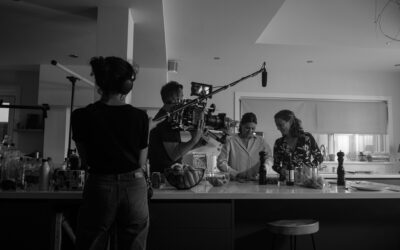Successful corporate storytelling is a lot harder than it looks. As I explained in part 1 of this 2-part article, finding the perfect alignment of story, insight, and message in a corporate film can be quite complex. It means using sophisticated techniques to subtly lead the viewer to your message, instead of putting a spotlight on it throughout the film. And it means finding a connection between story, insight, and message that makes sense and rings true.
In this second part, I’d like to focus more on the narrative content itself, discussing the concept of negativity – a crucial but daunting aspect in corporate storytelling – and how we used it to infuse Achmea’s new corporate film Sustainable Living, together. The Achmea way with positive value.
Negaphobia
Negativity is a bit of a dirty word in corporate communication. As most large organisations favor a risk-averse way of working, communication professionals tend to avoid anything negative in corporate messaging. Instead, they keep it positive and light, focus on the benefits of products and services, and use only words and images that are pleasurable, hopeful, and happy. Their fear is that any negative association audiences may have with the organisation could be a risk to its image or sales. Robert McKee calls it ‘negaphobia’ in his book Storynomics: Story-driven marketing in the post-advertising world,[1] the fear of any type of negative statement or sentiment in communication.
In specific instances, negaphobia has its merits. We all know the experience of seeing a TV ad that uses horrific imagery to attract our attention to an important cause like fighting famine or animal cruelty. Unfortunately, ads like these make us feel the urge to look away or change the channel and may do a charity more harm than good.
But negaphobia becomes problematic – irrational even – when it discards all negative elements from corporate storytelling. Because the best stories are stories of struggle, challenges, and hardship. There is no way to tell a good story without addressing the darker sides of life, in some way.
In fact, research bears this out: The potentially positive effects of storytelling are diminished if you avoid eliciting negative emotions. Marketing researcher Chuck Young found out that pieces of corporate storytelling that ‘keep it light’ garner at best only 75% of the attention those same works get when negativity is part of the story[2]. He explains why: “Negative emotions at the start can grab the viewer’s attention and draw her in to the ad. (…) By dramatizing a problem your brand will solve, negative emotions can drive motivation.”
Attention and engagement
When you delve a bit deeper in Young’s research on the topic, it’s quite clear that employing negative emotions is not just an extra ingredient in corporate storytelling – it’s crucial. According to his research, stories that include negative aspects not only garner more attention, but they also tend to score much higher on positive engagement with the message and enhance motivation to interact with the company behind the film.
If you are already familiar with storytelling techniques, these results are no surprise. That’s because negativity is a key ingredient of any good story. Every well-crafted story starts with a minor or major upheaval in the life of the story’s protagonist. It is that negative development that pushes the hero towards adventure, and only after struggle and overcoming hardship will (s)he find a new balance in life.
So, negativity drives plot forward. But it also gives stories their meaning. By experiencing struggle through the eyes of a character, we get to live others’ lives and learn from the results of the choices they make under pressure. By showing us the tragedies and victories others experience as a result of strife, stories provide us with tools to live, insights into life.
This example illustrates the need for a dose of negativity in honest, impactful corporate storytelling perfectly:
Did you notice how the filmmakers skillfully play with the balance between negative events and the twist towards a positive, hopeful message. It’s a daunting balance, but the filmmakers carefully manage their audience’s expectation, from being curious about the story to having confidence it will end on a feel-good note.
A daunting balance: the Achmea case
But – there’s always a but – finding the most meaningful and engaging way to create balance between the negative and the positive is daunting. As Chuck Young puts it, “playing with the dark force can be risky”. In making insurance company Achmea’s new corporate film, Sustainable Living, together. The Achmea way, this meant finding the exact right narrative structure to lead viewers from anticipation via drama to hope. Here’s the film if you haven’t seen it yet:
As you can see, negative emotions such as shock, despair, and doubt are central to the first half of the film. In the five storylines presented, characters each experience a moment in which their life is turned upside down, such as a car crash, a house fire, and a ransomware attack. Pretty dark stuff.
These negative upheavals set in motion a plethora of support mechanisms: people rushing to the crash site, repairmen recreating the fire-damaged house, cyber experts salvaging locked-up data, and of course Achmea facilitating many of these forms of support. The film ends on a strong sentiment of hope.
As I described in my previous article, the five storylines are designed to show the values we intended to convey in the film: the power of solidarity – helping out those in need – and the importance of continuity – picking up the pieces of a shattered life and finding new purpose. When you see the finished film, it’s obvious conveying these positive values would have been much harder without first showing intense negative experiences. It’s the progress from negative to positive that makes it work.
But when we started the development process and pitched our ideas to Achmea, we weren’t sure how Achmea would respond. It’s a dictum in the insurance world that you don’t show the tragic events people are insured against, but only address them obliquely, for instance by showing positive outcomes of insurance claims, or by softening the drama with light-hearted humour. But, as Chuck Young’s research shows, this negaphobic approach means your chances of engaging viewers with your message are severely diminished, even when the execution of the communication strategy is perfect.
Fortunately, Achmea understood that the film we wanted to make wouldn’t be exploitative or create any negative associations with Achmea, but would tell honest stories of loss and recovery, with a focus on solidarity and continuity.
Brain scans
Of course, when the film was finished, Achmea and we at 1Camera were both curious if our bold approach had worked. So Achmea employed science to find out what a viewer’s emotional response would be to the corporate film. Neuromarketing research company Neurensics conducted fMRI brain scans, combined with other types of research, to find out how viewers respond to the film moment by moment, what sentiments were evoked in them, and if the overall sentiment that viewers attached to the film was as positive as we had intended.
To be honest, we were a bit nervous. What if we had been wrong? What if people found the film depressing?
Thankfully, the results surprised even us. Ours was among the 15% most engaging corporate films Neurensics had ever tested. And the emotions we were trying to evoke in every scene were in fact registered as such by the viewers. Furthermore, the overall sentiment viewers experienced after seeing the film was positive: they felt strong engagement and appreciation. Science showed true storytelling works – when executed properly.
So why does the Achmea film score so well in the fMRI test? It’s a result of the structure of the film and the way narrative content – both negative and positive – is presented to the viewer in the right context. Because making sure an overall positive sentiment remains after watching the film isn’t just a matter of balancing out negative moments with enough positivity to cancel them out. It’s more sophisticated than that.
In control of the narrative
What’s special about the Achmea film is that it starts by announcing to the viewer that bad things are about to happen – the storytelling technique known as foreshadowing. The onscreen text prepares you for that. As a result, those negative events are anticipated and are experienced as less shocking. The announcement is a way of saying to the viewer: You don’t know what’s about to happen next, but all will be right in the end.
Neurensics’ research shows this works as planned: When disaster strikes in the film – the car crashing, the house burning down – viewers are impacted emotionally, but they are not devastated. As viewers are already prepared for further narrative development, they anticipate a positive outcome so they remain hopeful even in those dramatic moments. A benefit of creating this form of anticipation is that viewers are fully engaged in the story, completely committed to finding out how the story will turn towards a hopeful outcome for the main characters.
This is why storytelling – true storytelling – is such a strong tool in corporate communication. Guiding your viewers through strong, emotional moments – like we do in the Achmea film, but also in the great example below – is a way of making sense of the world around us, of infusing moments with meaning and value, experiencing life’s most challenging and tragic moments – but with a safety net.
This video is another example of how the filmmakers crafted the script, using contrast and juxtaposition in this case, to make sure the viewer stays confident that the film will end on a positive, hopeful note, while the struggles are truthful and make sure the story is felt and meaningful.
Organize the flow of emotions
Chuck Young points to the same notion in his article. “The job of a commercial is not just to evoke an emotional response, but to organize the flow of emotional reactions throughout the film, to achieve particular dramatic effects.” He compares these types of films to batteries, “with both a negative and positive charge; the goal is to create a current of emotional energy between the two poles.”
Of course, it takes years and years of experience to perfect this particular narrative skillset. Playing with the dark force can indeed be risky in unsteady hands. But if you want to create truly compelling stories that touch the heart and soul of those you want to reach in a profound way, you have to embrace both the positive and the negative.
You simply have to be true to life.
– Jasper
[1] https://mckeestory.com/books/storynomics/
[2] Chuck Young, “The use of negative emotions in advertising”, Admap Magazine, October 2006, pp. 18-21


